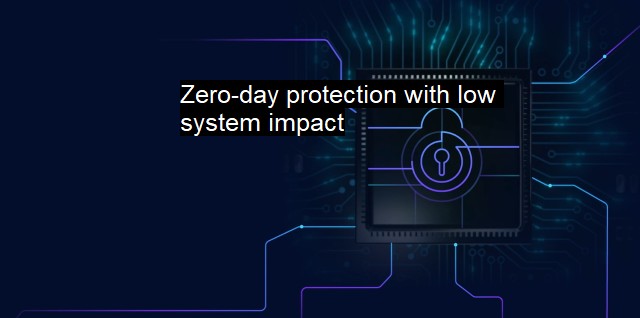What is Zero-day protection with low system impact?
Unseen Heroes: Exploring the Criticality of Zero-day Protection and Techniques for Fool-proof Cybersecurity
Zero-day protection with low system impact stands at the intersection of cybersecurity and antivirus solutions. Fostering a secure online landscape while attenuating resource utilization is the primary goal of such systems.To better understand what zero-day protection entails, it would be useful to first grasp the concept of a zero-day attack. A zero-day attack takes advantage of loopholes in software that are completely unknown to those interested in fixing these flaws, such as the software vendor or antivirus programmers. These glitches could be a simple software bug that inadvertently allows an attacker to sneak into a system or a cyber intruder being the first to identify a vulnerability in a program and tampering with it before any patch deployment. Critically, this implies that zero-day vulnerabilities are exploited before the creators or vendors become aware of their existence, hence leaving no "day zero" for preparations or proactive measures.
Hence, zero-day protection refers to defense mechanisms and strategies tailored to tackle these zero-day threats without a known solution or patch. This poses notorious challenges since typical antivirus or security programs operate to counter known malware or threats. Running in the background, modern antivirus software employs various technologies to recognize potentially malicious codes or suspicious behaviors and block them to protect the user. These technologies ideally provide real-time protection against known threats, leveraging continually updated "signature lists" of malicious codes that the software recognizes and neutralizes.
Covering unknown zero-day threats, as opposed to known malware types, requires a more dynamic and proactive approach, as these threats do not possess recognizable "signatures." Zero-day protection measures often involve heuristic analysis, proactive threat hunting, behavioral analysis, machine learning algorithms, and artificial intelligence (AI). these mildly to highly sophisticated technologies don't merely compare files against signature lists but inspect activities exhibited by applications to identify possible anomalies.
While zero-day protection is remarkably crucial in today's ever-evolving digital landscape, it must not exert overly considerable system strain or substantially consequential system impact. Businesses and individuals alike are increasingly wary of their cybersecurity measures interfering with their everyday operations or impairing system performance, making low system impact a sought-after attribute in antivirus solutions.
Nearly all computer programs require system resources such as processing power and memory to function. This also applies to antivirus solutions that actively scan items on storage, monitor file activities, and manage internet traffic, among other operations. As a result, resource-demanding antivirus activities could correspondingly slow down other operations, especially on systems with limited resources. Achieving low system impact as a feature of antivirus and cybersecurity solutions, therefore, is about improving overall system performance by optimizing the functionality of these solutions to utilize minimal resources while delivering maximum protection.
This could involve encoding the security solution to execute scans when the system is idle (thereby using resources when they are not crucially demanded by other processes). Alternatively, it could mean optimizing the amount of memory these solutions occupy with enhanced data management techniques or reducing processor usage by optimizing programmatic code.
Zero-day protection with low system impact encapsulates a forward-thinking, holistic cybersecurity approach specifically emphasizing resource optimization. It involves proactive measures to identify, understand, and counteract unknown threats or vulnerabilities instantly (zero-day protection). Concurrently, it entails constantly honing these provisions such that they deliver maximized security with minimally cumbersome demands on system resources (low system impact), facilitating relatively undisturbed and uninhibited system operations. In the ongoing struggle against increasingly sophisticated digital adversaries, such futuristic and efficient solutions carry immeasurable relevance for both organizations and individuals alike.

Zero-day protection with low system impact FAQs
What is zero-day protection in cybersecurity?
Zero-day protection in cybersecurity refers to the defense mechanisms employed by antivirus software to protect a system against vulnerabilities that have not yet been detected or made public.What is low system impact?
Low system impact is a term used to describe antivirus software that operates without negatively affecting the performance or speed of a computer.How does zero-day protection with low system impact work?
Antivirus software with zero-day protection and low system impact continuously monitor a computer for suspicious behavior and unknown threats. This is achieved through a range of techniques, including behavioral analysis, machine learning, and real-time threat intelligence.Is zero-day protection with low system impact effective against all types of cyber threats?
While no antivirus software can provide 100% protection against all cyber threats, employing zero-day protection with low system impact significantly reduces the risk of malware infection and data breaches. Additionally, regular software updates and maintaining good cybersecurity hygiene further enhances protection against known and unknown threats.| | A | | | B | | | C | | | D | | | E | | | F | | | G | | | H | | | I | | | J | | | K | | | L | | | M | |
| | N | | | O | | | P | | | Q | | | R | | | S | | | T | | | U | | | V | | | W | | | X | | | Y | | | Z | |
| | 1 | | | 2 | | | 3 | | | 4 | | | 7 | | | 8 | | |||||||